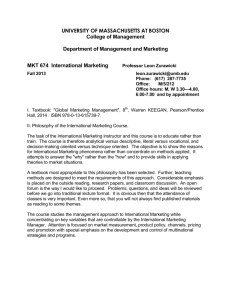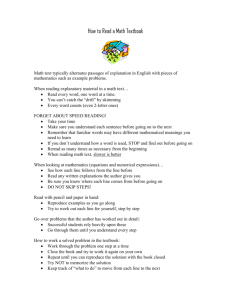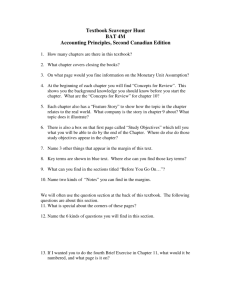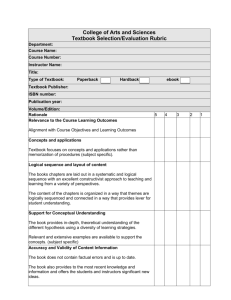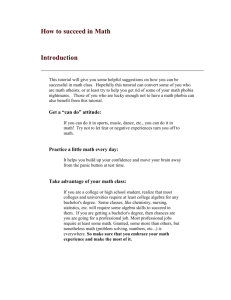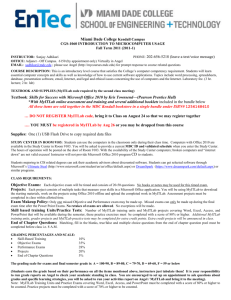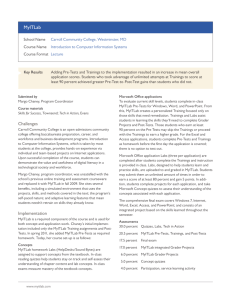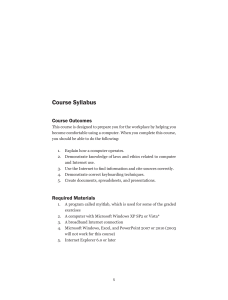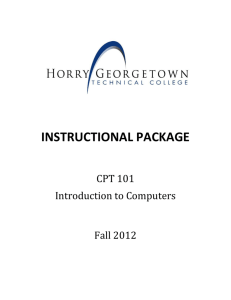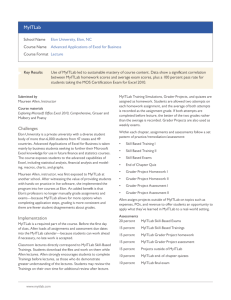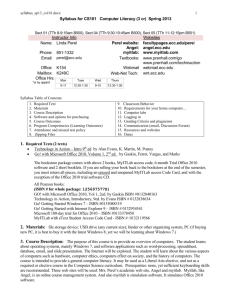Mat/Sta/CMP Department - Nassau Community College
advertisement
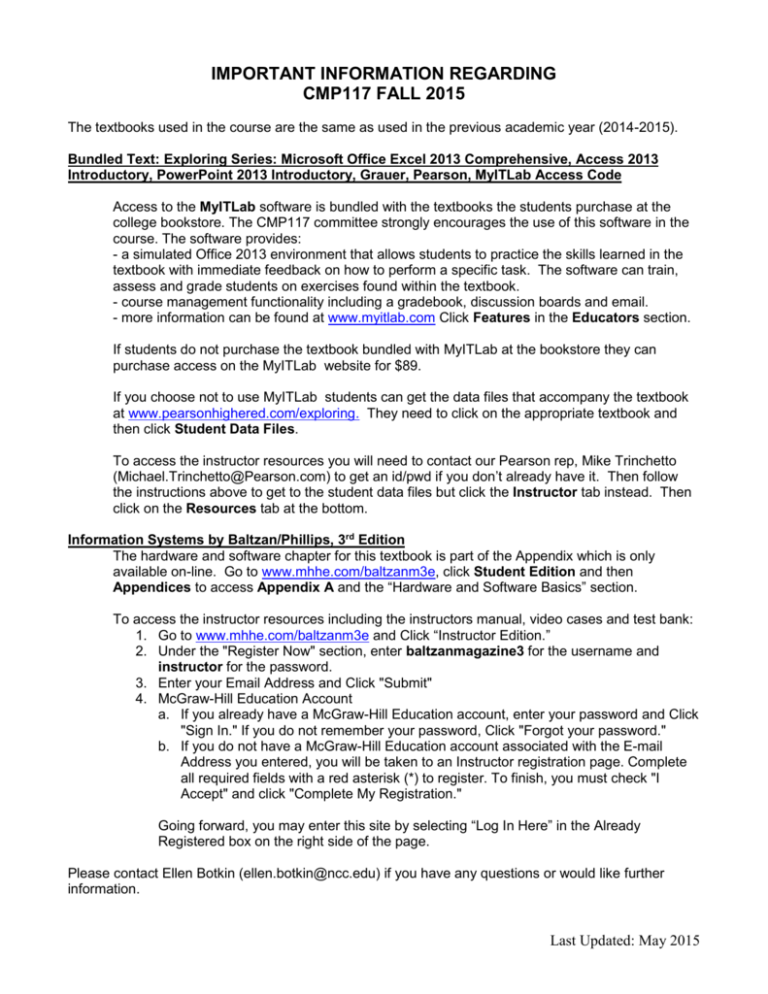
IMPORTANT INFORMATION REGARDING CMP117 FALL 2015 The textbooks used in the course are the same as used in the previous academic year (2014-2015). Bundled Text: Exploring Series: Microsoft Office Excel 2013 Comprehensive, Access 2013 Introductory, PowerPoint 2013 Introductory, Grauer, Pearson, MyITLab Access Code Access to the MyITLab software is bundled with the textbooks the students purchase at the college bookstore. The CMP117 committee strongly encourages the use of this software in the course. The software provides: - a simulated Office 2013 environment that allows students to practice the skills learned in the textbook with immediate feedback on how to perform a specific task. The software can train, assess and grade students on exercises found within the textbook. - course management functionality including a gradebook, discussion boards and email. - more information can be found at www.myitlab.com Click Features in the Educators section. If students do not purchase the textbook bundled with MyITLab at the bookstore they can purchase access on the MyITLab website for $89. If you choose not to use MyITLab students can get the data files that accompany the textbook at www.pearsonhighered.com/exploring. They need to click on the appropriate textbook and then click Student Data Files. To access the instructor resources you will need to contact our Pearson rep, Mike Trinchetto (Michael.Trinchetto@Pearson.com) to get an id/pwd if you don’t already have it. Then follow the instructions above to get to the student data files but click the Instructor tab instead. Then click on the Resources tab at the bottom. Information Systems by Baltzan/Phillips, 3rd Edition The hardware and software chapter for this textbook is part of the Appendix which is only available on-line. Go to www.mhhe.com/baltzanm3e, click Student Edition and then Appendices to access Appendix A and the “Hardware and Software Basics” section. To access the instructor resources including the instructors manual, video cases and test bank: 1. Go to www.mhhe.com/baltzanm3e and Click “Instructor Edition.” 2. Under the "Register Now" section, enter baltzanmagazine3 for the username and instructor for the password. 3. Enter your Email Address and Click "Submit" 4. McGraw-Hill Education Account a. If you already have a McGraw-Hill Education account, enter your password and Click "Sign In." If you do not remember your password, Click "Forgot your password." b. If you do not have a McGraw-Hill Education account associated with the E-mail Address you entered, you will be taken to an Instructor registration page. Complete all required fields with a red asterisk (*) to register. To finish, you must check "I Accept" and click "Complete My Registration." Going forward, you may enter this site by selecting “Log In Here” in the Already Registered box on the right side of the page. Please contact Ellen Botkin (ellen.botkin@ncc.edu) if you have any questions or would like further information. Last Updated: May 2015 NASSAU COMMUNITY COLLEGE DEPARTMENT OF MATHEMATICS/COMPUTER SCIENCE/INFORMATION TECHNOLOGY Course Outline for CMP 117 Business Computing: Concepts and Applications Curriculum Interdisciplinary Lab hours 18 Semesters offered Indicated in Catalog Length of semester 15 Weeks Class hours 4.5 Credits 4 Text Information Systems, Baltzan, Phillips, 3rd Edition, McGraw-Hill ISBN: 9780073376912 AND Bundled Text: Exploring Series Microsoft Office Excel 2013 Comprehensive, Microsoft Office Access 2013 Introductory, Microsoft Office PowerPoint 2013 Introductory, Grauer, 1st Edition, Pearson, also includes access to myitlab Bundled ISBN: 0133952134 PREREQUSITE Students must have satisfied all MAT, ENG 001 and RDG 001 remediation requirements prior to starting the course. CATALOG DESCRIPTION This course is designed to provide the business student with a broad-based background in the use of computer systems in business and industry. An overview of computer hardware and software concepts with their impact on business systems is an integral part of the course. Students are introduced to a variety of information systems and the development life cycle utilized in the private sector. The importance of networking structures and the analysis of data flow within business and management information systems (MIS) are covered. Use of the Internet for global electronic commerce is discussed. The hands-on component of the course provides students with substantial use of spreadsheet, database and presentation software to analyze data and solve real-life business problems. Students will be introduced to databases that exhibit the hierarchy of data and the relational database model. (Students will not receive credit for both CMP 115 and CMP 117; Computer Science or Information Technology majors will not receive credit for this course.) Laboratory fee applies. Last Updated: May 2015 COMPUTER CENTER REQUIREMENT Students should avail themselves of further study and/or educational assistance available in the Computer Learning Center located in room B-225 as part of this course. These services are to be considered an integral part of the course work and will help the student master the necessary knowledge and skills for this course. DISABILITY STATEMENT If you have a physical, psychological, medical, or learning disability that may have an impact on your ability to carry out the assigned coursework, I urge you to contact the Center for Students with Disabilities(CSD), Building U,(516 572-7241),TTY(516) 572-7617. The counselors at CSD will review your concerns and determine reasonable accommodations you are entitled to by the Americans with Disabilities Act and Section 504 of the Rehabilitation Act of 1973. All information and documentation pertaining to personal disabilities (diagnoses) will be kept confidential. OBJECTIVES General Upon completion of this course, the student will: 1. Be acquainted with the nature and purpose of computers and their role in business. 2. Have knowledge of computer software and computer use as a means of classifying, operating upon, and reporting information from processed data. 3. Know what computing configurations may be found in typical businesses and acquire knowledge of the functions of different types of computer hardware. 4. Have an understanding of business systems and their operations. 5. Have the knowledge and ability to use computer software to solve common business problems. 6. Have extended exposure to business application software and its functionality as it pertains to the business environment 7. Identify the general structure of the Internet and be able to describe the benefits and features of conducting global business on the Internet. Specific: Instructional Notes: The class meets 3 days a week and should be structured such that at least one day is spent on topics contained in the computer lab component. Whenever possible, relate the computer lab component of the course to the lecture component of the course. COURSE OUTLINE LECTURE COMPONENT (22 sessions) The instructor does not necessarily need to follow the sequence of the topics presented below. The following chapters should be covered in the Information Systems Textbook: Chapter 1 Management Information Systems: Business Driven MIS Chapter 2 Decisions and Processes: Value Driven Business Chapter 3 Ebusiness: Electronic Business Value Chapter 4 Ethics and Information Security: MIS Business Concerns Chapter 5 Infrastructures: Sustainable Technologies Chapter 6 Data: Business Intelligence Chapter 7 Networks: Mobile Business Chapter 8 Enterprise Applications: Business Communications Chapter 9 Systems Development and Project Management: Corporate Responsibility Appendix A: Hardware & Software (found at www.mhhe.com/baltzanm3e) Last Updated: May 2015 I. INTRODUCTION TO INFORMATION SYSTEMS (2 Sessions) A. The evolution of computers and their impact on today's business world. B. How a computer processes information - the data processing cycle. C. Hardware and software. D. Types of Computers. E. Types of business applications packages, i.e., word processing, database, spreadsheets, graphics, desktop publishing, accounting packages, desktop utilities, etc. II. HARDWARE (2 Sessions) A. Memory B. The Central Processing Unit (CPU) and its components. C. Methods of processing data – online, batch and transactional. D. Input/Output devices and their involvement in data handling. A. Primary/Secondary storage. B. Disk/Tape/CD/DVD storage. C. File storage and backup methods. E. Integrity controls III. SOFTWARE (2 Sessions) A. System Software (Operating systems) – pc, mainframe, server, handheld B. Application Software IV. DATABASE (2 Sessions) A. The hierarchy of data - character, field, file, database. Key fields and descriptive fields. B. Relational model C. Physical/Logical Design, Cardinality: one-to-many, many-to-many, one-to-one relationships D. Data Normalization V. DATA COMMUNICATIONS AND NETWORKS (1 Session) A. Components of a data communications system. B. Data Communications hardware & software. C. Networks: Hardware and software topologies. D. Data communications applications, i.e., E- Mail, banking, telecommuting, etc. VI. THE INTERNET (1 Session) A. The general structure and function of the Internet, the World Wide Web, and E-Mail. B. Browsers, portals, ISPs. C. The impact of the Internet on management, accounting, marketing, and other business procedures. D. Intranet, Extranet E. Internet security. F. Future trends. VII. E-COMMERCE (1 Session) A. B2C, B2B, C2C, B2G B. Secure websites C. Global ecommerce model and issues D. M-commerce Last Updated: May 2015 VIII. SYSTEMS ANALYSIS & DESIGN (2 Sessions) A. The system development life cycle: 1. Analyzing 2. Planning 3. Design 4. Implementing 5. Testing and Documentation B. Internal controls C. Low-level languages D. High-level languages E. Structured programming IX. INFORMATION SYSTEMS (4 Sessions) A. MIS in the organizational structure B. MIS hardware, software. C. Decision Support Systems (DSS). D. Expert systems. E. Enterprise systems F. Managing information software. . INTERNAL CONTROLS (1 Session) A. Fraud & prevention B. Organizational controls over EDP OPERATIONS C. Documentation controls. D. Hardware, i.e., self-diagnosis, security. E. Input controls (validity checks, limit tests, data integrity). F. Processing controls (file, header labels, backups). G. Output and distribution controls. H. Auditing. X. XI. INFORMATION SYSTEMS ISSUES (2 Sessions) A. Computer waste, mistakes B. Fraud C. Computer crimes and scams D. Privacy issues XII. CASE STUDIES (2 Sessions) Students should participate in discussing case studies which highlight how an organization has used technology. The case studies can depict either successful or unsuccessful implementations of technology. They should be presented concurrently with the computer lecture and computer laboratory components of the course. Whenever possible, relate the case study to the material being presented in the lab and lecture components of the course. Last Updated: May 2015 COMPUTER LAB COMPONENT (18 Sessions) Note: The computer lab component of the course runs concurrently with the computer lecture component of the course. Whenever possible, relate the computer component of the course to the lecture component of the course. The instructor does not necessarily need to follow the sequence of the topics presented below. The following chapters should be covered in the Excel Textbook: Chapter 1 Introduction to Excel Chapter 2 Formulas and Functions Chapter 3 Charts Chapter 4 Datasets and Tables Chapter 5 Subtotals, PivotTables, and PivotCharts (HOE 1 only) Chapter 6 What-If Analysis (HOE 1 and 2 only) Chapter 9 Multiple-Sheet Workbook Management (HOE 1 and 2 only) The following chapters should be covered in the Access Textbook: Chapter 1 Introduction to Access Chapter 2 Tables and Queries in Relational Databases Chapter 4 Creating and Using Professional Forms and Reports The following chapters should be covered in the PowerPoint Textbook: Chapter 1 Introduction to PowerPoint Chapter 3 Presentation Design I. INTRODUCTION (1 Session) A. Windows operating system basics: drives, folders, files, file types B. Introduction to the hardware used in the labs, J drive for student use C. Instructors may elect to use Microsoft Word to provide an overview of the operational characteristics of the Microsoft Office Software Suite. II. SPREADSHEETS USING EXCEL (11 Sessions) Note: Specific accounting/business applications should be covered using the spreadsheet component of the course. They include: 1. Payroll 2. Inventory 3. Accounts Receivable 4. Cost-Volume-Profit Anaylsis (Break-Even Analysis) 5. Budgeting INTRODUCTION A. Overview – spreadsheets B. Creating the worksheet C. Moving around in the worksheet D. Labels, values, formulas, functions E. Menus and Toolbars F. Saving, replacing and retrieving files Last Updated: May 2015 ENHANCING A WORKSHEET A. Managing rows/columns B. Formatting C. Conditional formatting FORMULAS AND FUNCTIONS A. Functions: SUM, MAX, MIN, AVERAGE, IF, PMT, VLOOKUP B. Absolute and relative addressing C. Named Range D. Combining data from other worksheets into a summary worksheet CHARTS A. Creating a chart and data ranges B. Enhancements, i.e. color, grids, etc. TABLES A. Large datasets and creating tables B. Sorting/filtering data C. Aggregating table data (total row) WHAT-IF ANALYSIS A. One and two variable data tables B. Goal Seek C. Scenario Manager III. DATABASE CONCEPTS USING ACCESS (4 Sessions) A. Overview of Access Interface B. Tables, Fields, Data Types C. Primary and Foreign Keys D. Forms for inputting data E. Using the Query tool F. Using the Report Generator IV. PRESENTATIONS USING POWERPOINT (3 Sessions) A. Creating slides, slide layout, slide design templates B. Formatting slides C. Clip Art D. Transitions E. Animation F. Students should give their presentations to the class ****************************************************************************** EXAMINATIONS (4 Sessions) 3 Examinations and 1 Final Examination ***************************************************************************** COMPUTER PROJECTS 10-15 computer lab assignments throughout the semester Total number of Sessions: 45 Last Updated: May 2015
